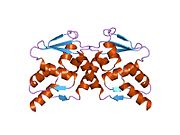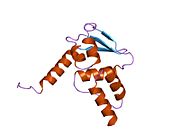BCL6
Ensembl | |||||||||
|---|---|---|---|---|---|---|---|---|---|
| UniProt | |||||||||
| RefSeq (mRNA) | |||||||||
| RefSeq (protein) | |||||||||
| Location (UCSC) | Chr 3: 187.72 – 187.75 Mb | Chr 16: 23.78 – 23.81 Mb | |||||||
| PubMed search | [3] | [4] | |||||||
| View/Edit Human | View/Edit Mouse |
Bcl-6 (B-cell lymphoma 6) is a protein that in humans is encoded by the BCL6 gene. BCL6 is a master transcription factor for regulation of T follicular helper cells (TFH cells) proliferation.[5] BCL6 has three evolutionary conserved structural domains.[6] The interaction of these domains with corepressors allows for germinal center development and leads to B cell
The deletion of BCL6 is known to lead to failure of germinal center formation in the follicles of the lymph nodes, preventing B cells from undergoing somatic hypermutation.[6] Mutations in BCL6 can lead to B cell lymphomas because it promotes unchecked B cell growth.[6] Clinically, BCL6 can be used to diagnose B cell lymphomas and is shown to be upregulated in a number of cancers.[6]
Other BCL genes, including
.Normal physiological function
Structure
The protein encoded by the BCL6 gene is a
Function
Bcl-6 is a master transcription factor for the regulation of T follicular helper cells (TFH cells). Bcl-6 is expressed when the cytokines Il-6 and/or Il-21 are recognized; these cytokines can be produced by antigen presenting cells (APCs: B cells, dendritic cells, or macrophages) when activated. This occurs when a naïve T helper cell recognizes antigen and needs to migrate to the follicle as a T follicular helper cell (TFH cell).[8] TFH cells are vital to the generation of germinal centers in the follicles of secondary lymphoid organs, where B cells divide and help fight infections.[5]
As a master transcription factor, BCL6 interacts with a variety of co-repressors and other proteins to influence the T cell lineage. BCL6 has been shown to modulate the STAT-dependent
Importantly, Bcl-6 should only be expressed when there is an antigen present and further stimulation of the immune system is necessary, since BCL6 prevents cell death (
Differentiation of TFH Cells
BCL6 is currently considered a lineage-defining transcription factor in TFH cell differentiation.[10] Without the expression of BCL6, naïve CD4+ T helper cells will not turn into TFH cells. When a naïve CD4+ T cell binds to MHC class II and an antigen peptide on a dendritic cell, a signaling cascade ensues in which some proliferating T cells become TFH cells. Signaling through the IL-6 receptor leads to TFH cell differentiation, and in turn the expression of BCL6 in TFH lineage-defined cells. BCL6 allows, through transcriptional regulation, unique cell markers to be expressed, resulting in an effective TFH cell.[10]
Transcriptional regulation of BCL6 is vast and complex, but many of the outcomes of BCL6’s transcriptional regulation on TFH cells have been elucidated. TFH cells upregulate CXCR5, IL-6R, and ICOS during their migration to the germinal center. After interacting with a B cell presenting the cognate antigen in the follicle, they also upregulate SAPhi, CD200hi and BTLAhi on their cell surface in the newly formed germinal center. Additionally, BCL6 directly binds and suppresses genes that are downregulated in non-TFH cells, including Ccr7, Selplg, and Gpr183, and other chemokine receptor targets.[10]
Clinical Value
Role in B Cell Lymphomas
BCL6 is found to be frequently translocated and hypermutated in
Many different changes to BCL6 can lead to inhibited activity and are known to be linked with B-cell lymphomas, including direct effects (mutation and post-translational effects) as well as indirect effects (imbalanced interactions with other mutated proteins). Mutations to the transcription factors for BCL6, MEF2B and IRF8, are common in direct transcriptional changes that cause DLBCL. Additionally, post-translational
Given its role as a master transcription regulator, many genetic and epigenetic changes can be responsible for B-cell lymphomas; these interacting proteins are likely a few of many that affect BCL6’s function.Diagnostic Ability
Tracking BLC6 in B cells using immunohistochemical staining or enzyme-linked immunosorbent assay (ELISA) can be used to diagnose cancers and may indicate other illnesses as well. As mentioned previously, tracking BCL6 in tandem with BCL2 can lead to the diagnosis of B-cell lymphomas. More recently, it has been hypothesized that the presence of BCL6 in serum could be used to diagnose endometriosis due to an overactivation of BCL6 in endometriotic females,[15][16] although this diagnostic method has not been found to work.[17] Nonetheless, the understanding of BCL6 will likely continue to be used to diagnose diseases.
Targeted Therapies
Given BCL6’s role in B-cell lymphomas, it has been suggested as a therapeutic target for cancer treatment. Targeting BCL6 in cancer patients should lead to the deletion of BCL6 in tumor cells. Peptidomimetics, small molecules, and natural compounds have been developed and tested in preclinical models, showing promise of anti-lymphoma activity.[18]
Interactions
BCL6 has been shown to
See also
- Nodular lymphocyte predominant Hodgkin's lymphoma
- Diffuse large B cell lymphoma
References
- ^ a b c GRCh38: Ensembl release 89: ENSG00000113916 – Ensembl, May 2017
- ^ a b c GRCm38: Ensembl release 89: ENSMUSG00000022508 – Ensembl, May 2017
- ^ "Human PubMed Reference:". National Center for Biotechnology Information, U.S. National Library of Medicine.
- ^ "Mouse PubMed Reference:". National Center for Biotechnology Information, U.S. National Library of Medicine.
- ^ )
- ^ PMID 31788471.
- PMID 22609116.
- PMID 19628815.
- PMID 19608860.
- ^ PMID 33663954.
- PMID 8235596.
- S2CID 12575122.
- PMID 8618933.
- )
- PMID 28754906.
- PMID 27222232.
- PMID 34698105.
- S2CID 22638255.
- ^ PMID 10898795.
- PMID 12165517.
- ^ PMID 9627120.
- ^ PMID 10611298.
- ^ PMID 11929873.
- PMID 10601358.
- ^ PMID 9765306.
- PMID 9927193.
- PMID 21518797.
- PMID 11175338.
Further reading
- Ueda C, Akasaka T, Ohno H (July 2002). "Non-immunoglobulin/BCL6 gene fusion in diffuse large B-cell lymphoma: prognostic implications". Leukemia & Lymphoma. 43 (7): 1375–81. S2CID 27096971.
- Niu H (December 2002). "The proto-oncogene BCL-6 in normal and malignant B cell development". Hematological Oncology. 20 (4): 155–66. S2CID 24245607.
- Tokuhisa T (December 2002). "[A role for Bcl6 in immune memory development]". Tanpakushitsu Kakusan Koso. Protein, Nucleic Acid, Enzyme. 47 (16 Suppl): 2306–12. PMID 12518453.
- Ohno H (April 2004). "Pathogenetic role of BCL6 translocation in B-cell non-Hodgkin's lymphoma". Histology and Histopathology. 19 (2): 637–50. PMID 15024721.
- Pasqualucci L, Bereshchenko O, Bereschenko O, Niu H, Klein U, Basso K, Guglielmino R, Cattoretti G, Dalla-Favera R (2004). "Molecular pathogenesis of non-Hodgkin's lymphoma: the role of Bcl-6". Leukemia & Lymphoma. 44 (Suppl 3): S5–12. S2CID 25565667.
- Jardin F, Ruminy P, Bastard C, Tilly H (February 2007). "The BCL6 proto-oncogene: a leading role during germinal center development and lymphomagenesis". Pathologie-Biologie. 55 (1): 73–83. PMID 16815642.
External links
- BCL6+protein,+human at the U.S. National Library of Medicine Medical Subject Headings (MeSH)
- Human BCL6 genome location and BCL6 gene details page in the UCSC Genome Browser.
This article incorporates text from the United States National Library of Medicine, which is in the public domain.



